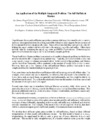An Application of the Multiple Knapsack Problem: The Self-Sufficient Marine
| dc.contributor.author | Simon, Jay | |
| dc.contributor.author | Apte, Aruna | |
| dc.contributor.author | Regnier, Eva | |
| dc.date.accessioned | 2019-04-23T19:01:54Z | |
| dc.date.available | 2019-04-23T19:01:54Z | |
| dc.date.issued | 2016-04 | |
| dc.identifier.citation | Simon, Jay, Aruna Apte, and Eva Regnier. "An application of the multiple knapsack problem: The self-sufficient marine." Proceedings of the 45th Annual Meeting of the Western Decision Sciences Institute. Western Decision Sciences Institute. 2016. | en_US |
| dc.identifier.uri | https://hdl.handle.net/10945/62017 | |
| dc.description | Presented at Western Decision Sciences Institute (WDSI 2016) conference April 5-9, 2016 | en_US |
| dc.description.abstract | Expeditionary forces such as Marine squads face a unique challenge: they must be able to survive and carry out required missions for as long as possible without external support, but are constrained by the amount that they can physically carry. Some of the items that they carry provide value by helping the squad conduct activities relevant to the mission, e.g. rifles and radios. Other items provide value by sustaining the squad, e.g. water and MREs (food rations). Determining the optimal load of items for a squad can be an extremely complex problem. | en_US |
| dc.format.extent | 2 p. | |
| dc.publisher | WDSI | en_US |
| dc.rights | This publication is a work of the U.S. Government as defined in Title 17, United States Code, Section 101. Copyright protection is not available for this work in the United States. | en_US |
| dc.title | An Application of the Multiple Knapsack Problem: The Self-Sufficient Marine | en_US |
| dc.type | Conference Paper | en_US |
| dc.contributor.corporate | Naval Postgraduate School (U.S.) | en_US |
| dc.contributor.department | Business & Public Policy (GSBPP) |


